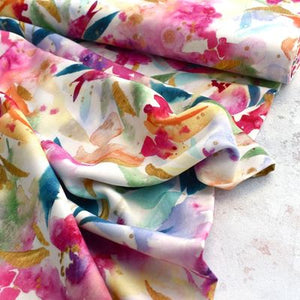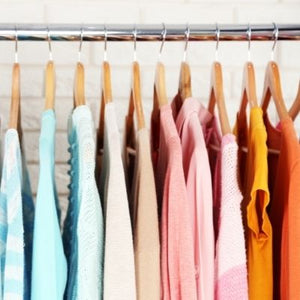Did you know that linen is considered the very first fabric? Or that it is also a very sustainable choice? With humble beginnings dating back thousands of years, linen remains a popular choice for garments and other items of all types due to its unique inherent properties. Let's take a deeper look at why linen remains a favorite among sewists and what to consider when adding it to your handmade wardrobe.

Fabric Facts
- Sustainability—Linen has long been an eco-conscious choice. Not only is it fully bio-degradable and very renewable, it's strength (2 to 3 times stronger than cotton!) and versatility also make it a fabric made to last. One disadvantage is this fiber is labor-intensive to produce, leading to a higher price.
- Keep Cool—Known as a summer staple, linen is recognized for its ability to keep the wearer cool and dry in warm weather due to its high absorbency and breathability. Oh, and did we mention it is also moisture-wicking, antibacterial, and hypoallergenic!
- Mix it Up—Though lovely on its own, linen is often blended with other fibers, such as rayon, cotton, and polyester, to achieve a preferred drape or ease of care. Rayon blends offer more softness and drape, while cotton blends offer more structure and less wrinkling.

- Sew the Rainbow—Because natural fibers tend to absorb dye and are more colorfast than their synthetic alternatives, linen is found in an infinite number of colors with various beautiful saturations, from subtle to vivid.
- Sewist's Choice—Linen is one of the easiest fabrics to sew, making it an outstanding choice for beginner sewists. It is stable, does not stretch, and gives off minimal lint. Its stability and weave also make it a great fabric to practice advanced beginner techniques such as gathering, darts, and facings.
Know Before You Sew
- Always pre-wash your linen fabric before sewing! Linen can shrink, and you'll be better off getting as much shrinkage out of the way ahead of time rather than fining out your garment no longer fits after laundry day!
- Because of its nature and weave, linen can be cut using either scissors or a rotary cutter, and standard pins work great for construction.
- When sewing, use a universal needle in a size that matches the weight of your fabric, along with a basic straight stitch, which is suitable for most projects.
- Be sure to press your garment thoroughly throughout the construction process; linen tends to crease quite easily.
- Linen can fray, so be sure to finish all seam allowances either with pinking shears, a serger, or a zig-zag stitch. French seams are also lovely and give garments a professional look.

- Linen is simple to care for, though it does tend to shrink. You can avoid this as much as possible by washing it in cold water, then drying it on low heat and removing it from the dryer before it is completely dry. Or skip the dryer and line dry.
- One adjective that always comes to mind when thinking about linen is "wrinkly"! Part of the charm and ease of this fabric is its lovably rumpled texture, though you do have the option to remove those wrinkles using an iron set to high heat. Some people also choose to utilize a bit of spray starch -- particularly on areas such as plackets, cuffs, and collars to get as crisp of a finish as possible.
Sew Smart! Linen is known for starting out somewhat stiff or even scratchy to the touch but softens over time with washing and wearing. Speed up this process by soaking your linen make in a bucket of cold water with 1/2 cup of dissolved baking soda. Swirl the fabric around every half-hour or hour and wash after it is removed. Usually, just a few hours in this solution will make a world of difference! Better yet, watch for linen fabric that comes pre-washed and softened in an enzyme bath!

Sew What?
- Linen is one of those truly versatile fabrics that have seemingly endless options! It is a perfect substrate for button-up shirts, blouses, tank tops, dresses, pants, tunics, skirts, shorts, blazers, suits, vests, and more.
- Its strength, durability, and ease of care, also make linen a valuable substrate for many home decor projects. Cloth napkins, tablecloths, pillowcases, bed sheets, duvet covers, curtains, and dishcloths are all great uses for this versatile fabric.
- Accessories made of linen have a timeless quality to them, and items such as tote bags, baby wraps, swaddling blankets, headbands, and ties are all classic gifts you can make and give or treat yourself!








I so much enjoy reading your articles and this one on linen is excellent! I’m always reaching for my long sleeve light weight linen button up shirt in the summer to stay cool and keep the sun off my skin. Keep up the great work! Cheers!
Hi, years ago(before they had steam irons) mom would always roll her cleaned linens in a towel and place them in the refrigerator. I asked her why she did this and she said that it was easier to get the wrinkles out. I tried it with my first linen blouse and it worked! Also, not only is linen for clothing, you can make all types of kitchen lines exp. towels/dish cloths, table linens and grandma made pillow cases and with the leftovers she used in a quilt.
Leave a comment